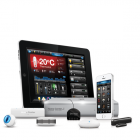You have no items in your shopping cart.
2-Way Lighting using Fibaro Relays
This guide shows how to use the Fibaro 1x3Kw Relay in a 2-way lighting system.
Each wiring diagram uses the cables that you will have available - you will not need to install any new cables. However, you do need to ensure that you have neutral available as the relay must have neutral.
Note: To simplify these diagrams, we have not shown the earth cables - but all circuits MUST have the earth cable correctly installed.
Firstly, what do we mean by 2-way lighting?
This simply refers to a lighting system where one light is controlled by two light switches. For example a room that has two entrances (each needs a light switch) or for a hall light that can be controlled from the hall and the upstairs landing.
There are a number of different 2-way circuit diagrams, we have covered all the common ones and have divided them depending one whether you will be installing the relay at the switch or in the ceiling.
Standard 2-Way Wiring

Figure 1: A standard 2-Way Wiring System.
A 2-core cable (brown and blue) carries the Live and Switched Live to the wall switch and up to the light fitting. An extra 3-core cable (brown, black and grey) connects the two wall switches together; enabling each of them to independently turn the light On or Off.
Note: in some installations two 2-core cables may have been used to connect the switches together, if this is the case the individual cables will be brown and blue rather than brown, black, and grey.
This type of lighting system uses 'Toggle' (latching) switches. These latch in position - for instance when you press the switch to On, the switch physically stays in the On position. These are the standard light switches you'll find already fitted in your home.
We can simply install the Fibaro 1x3Kw Relay into the 2-way circuit as shown in Figure 2.

Figure 2: 2-Way Wiring System using the Fibaro Relay.
The relay takes its Live connection from L1 and is controlled by the Switches L2 terminal. You need to have neutral available at the switch to use the relay in this circuit.
Fibaro Relay Parameter Setting:
The following parameters need to be set:
- 14 - 1 or 0 - enables the relay to work with a toggle (default) or momentary switches
You can also install the relay in the second switch.

Figure 3: Alternative 2-Way Wiring System using the Fibaro Relay.
Figure 3 shows how to add the Fibaro Relay into the second switch (Switch B). This does require some of the cables to be wired to the Relay rather than the switch, but you will not need to install additional wires. This wiring scheme will ONLY work with momentary switches.
Fibaro Relay Parameter Setting:
The following parameters need to be set:
- 14 - 0 - enables the relay to work with momentary switches
3-way Lighting - Toggle Switches
A 3-way lighting circuit is shown in Figure 4. This uses two 2-way switches (as you find in a 2-way circuit), but it also includes an Intermediate Switch that is in the 'middle' of the circuit. All switches are toggle type and each can control the light On/Off.

Figure 4: A 3-Way Lighting System with Intermediate Switch.
The simple way to add the Fibaro Relay into this circuit is to use Figure 4. This is very similar to figure 2.

Figure 5: Fibaro Relay installed in 3-way lighting system.
Fibaro Relay Parameter Setting:
The following parameters need to be set:
- 14 - 1 - enables the relay to work with a toggle switch (default)
2-way Lighting with alternative 2-wire System
This is a relatively new style of creating a 2-way lighting circuit. It is still uncommon in most buildings.

Figure 6: A 2-Way Lighting System using 2 wires between switches.
This system uses a 2-core (+ earth) cable between the two switches, instead of the more typical 3-core (+ earth) cable. You can install the Fibaro Relay in this circuit by using Figure 7 as a guide. In this circuit you MUST use Momentary Switches.

Figure 7: Fibaro Relay installed in a 2-wire 2-way system.
Fibaro Relay Parameter Setting:
The following parameters need to be set:
- 14 - 0 - enables the relay to work with a momentary switch
Ceiling Installation
This circuit is the standard one shown in Figure 1, but looking at the ceiling wiring rather than the switch wiring.

Figure 8: A standard 2-Way Wiring System (Ceiling View).
When installing the Relay in the ceiling you can largely ignore the switch wiring in this type of circuit. This is because it doesn't matter if the switches are wired as 1-way, 2-way, or 3-way with intermediate - the two wires that come from the switches to the light fitting are just Live and Switched Live. So we use these wires to control the Relay. This is actually the same wiring used in Figure 2, but in the ceiling rather than at the switch.
Figure 9: Fibaro Relay wired in the Ceiling - Standard multi-way circuit.
Fibaro Relay Parameter Setting:
The following parameters need to be set:
- 14 - 0 or 1 - depending if you wish to use momentary (0) or toggle (1) switches
Star Circuit
This is another ceiling installation circuit. This uses a 'star' formation where all switch wires are taken to a junction box in the ceiling and then feed the light. It looks more complicated than the standard circuit but is still straightforward to wire.

Figure 10: Star 2-way lighting circuit (Ceiling View).
The Fibaro Relay can be installed in a 'Star' 2-way circuit by following Figure 11

Figure 11: Fibaro Relay wired into a Star circuit.
Fibaro Relay Parameter Setting:
The following parameters need to be set:
- 14 - 0 or 1 - depending if you wish to use momentary (0) or toggle (1) switches
Earthing
All electrical circuits MUST be correctly Earthed.
All cables used in lighting circuits contain a bare Earth wire - this typically has a green/yellow sleeve when it is wired to the switch or back-box. The Earth is a very important part of the electrical system and all switches, appliances and lights must be correctly earthed.
For simplicity we do not show the earth wire in these drawings or explanations as it plays no active role in the day-to-day workings of your light circuits, it is there for your protection in case of emergency.
Disclaimer:
Installing the Fibaro Relay modules involve working with 240V mains wiring. If you are not comfortable doing this you should consult a qualified electrician. This application note is provided as a guide, all work is are carried out at your own risk. Vesternet do not accept any responsibility or liability.













